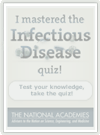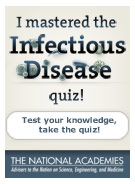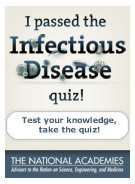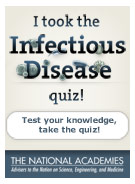
What You Need To Know About Infectious Disease
What do you know about infectious disease?
Which of the following is NOT a vector-borne disease?
-
Correct!
Influenza is not a vector-borne disease, meaning it is not transmitted to humans indirectly via an insect, an arthropod, or another animal. Malaria and yellow fever are transmitted by mosquitoes. Lyme disease is transmitted by deer ticks.
-
Sorry, that’s incorrect.
Influenza is not a vector-borne disease, meaning it is not transmitted to humans indirectly via an insect, an arthropod, or another animal. Malaria and yellow fever are transmitted by mosquitoes. Lyme disease is transmitted by deer ticks.
-
Sorry, that’s incorrect.
Influenza is not a vector-borne disease, meaning it is not transmitted to humans indirectly via an insect, an arthropod, or another animal. Malaria and yellow fever are transmitted by mosquitoes. Lyme disease is transmitted by deer ticks.
-
Sorry, that’s incorrect.
Influenza is not a vector-borne disease, meaning it is not transmitted to humans indirectly via an insect, an arthropod, or another animal. Malaria and yellow fever are transmitted by mosquitoes. Lyme disease is transmitted by deer ticks.
Which of the following is not a viral disease:
-
Sorry, that’s incorrect.
Trichinosis is not a viral disease. It is caused by a helminth (parasitic worm) found in undercooked meat, not by a virus.
-
Sorry, that’s incorrect.
Trichinosis is not a viral disease. It is caused by a helminth (parasitic worm) found in undercooked meat, not by a virus.
-
Correct!
Trichinosis is not a viral disease. It is caused by a helminth (parasitic worm) found in undercooked meat, not by a virus.
Which of the following is NOT a type of infectious agent?
-
Sorry, that’s incorrect.
White blood cells are not a type of infectious agent. Part of the immune system, white blood cells fight infection rather than cause it.
-
Sorry, that’s incorrect.
White blood cells are not a type of infectious agent. Part of the immune system, white blood cells fight infection rather than cause it.
-
Correct!
White blood cells are not a type of infectious agent. Part of the immune system, white blood cells fight infection rather than cause it.
-
Sorry, that’s incorrect.
White blood cells are not a type of infectious agent. Part of the immune system, white blood cells fight infection rather than cause it.
Which of the following can be treated with antibiotics?
-
Sorry, that’s incorrect.
Strep throat is a bacterial infection that can be treated with antibiotics. The common cold and influenza are both viral infections, which do not respond to antibiotics. Antivirals may be prescribed instead.
-
Correct!
Strep throat is a bacterial infection that can be treated with antibiotics. The common cold and influenza are both viral infections, which do not respond to antibiotics. Antivirals may be prescribed instead.
-
Sorry, that’s incorrect.
Strep throat is a bacterial infection that can be treated with antibiotics. The common cold and influenza are both viral infections, which do not respond to antibiotics. Antivirals may be prescribed instead.
-
Sorry, that’s incorrect.
Strep throat is a bacterial infection that can be treated with antibiotics. The common cold and influenza are both viral infections, which do not respond to antibiotics. Antivirals may be prescribed instead.
The human papillomavirus (HPV) causes about what percentage of cervical cancer cases?
-
Sorry, that’s incorrect.
The human papillomavirus (HPV) causes more than 90% of cervical cancer cases.
-
Sorry, that’s incorrect.
The human papillomavirus (HPV) causes more than 90% of cervical cancer cases.
-
Correct!
The human papillomavirus (HPV) causes more than 90% of cervical cancer cases.
How many people in the world do not have access to an adequate water supply?
-
Sorry, that’s incorrect.
Worldwide, 884 million people do not have access to an adequate water supply, and about three times that number lack basic sanitation services. An estimated 2 million deaths a year can be attributed to unsafe water supplies.
-
Sorry, that’s incorrect.
Worldwide, 884 million people do not have access to an adequate water supply, and about three times that number lack basic sanitation services. An estimated 2 million deaths a year can be attributed to unsafe water supplies.
-
Correct!
Worldwide, 884 million people do not have access to an adequate water supply, and about three times that number lack basic sanitation services. An estimated 2 million deaths a year can be attributed to unsafe water supplies.
Which of the following diseases is NOT caused by a virus?
-
Sorry, that’s incorrect.
Tuberculosis is caused by a bacterial infection. Chicken pox, the common cold, and influenza are all caused by viral infections.
-
Sorry, that’s incorrect.
Tuberculosis is caused by a bacterial infection. Chicken pox, the common cold, and influenza are all caused by viral infections.
-
Sorry, that’s incorrect.
Tuberculosis is caused by a bacterial infection. Chicken pox, the common cold, and influenza are all caused by viral infections.
-
Correct!
Tuberculosis is caused by a bacterial infection. Chicken pox, the common cold, and influenza are all caused by viral infections.
Which of the following is needed to help improve the public health situation in developing countries?
- More safe water supplies
- Better sewage treatment and disposal
- Improved food safety and vaccination programs
- All of the above
-
Sorry, that’s incorrect.
All of the above are urgently needed in developing nations. A major barrier to achieving these improvements is the underlying weakness of health systems in resource-poor countries, including a shortage of health workers and a lack of disease surveillance programs.
-
Sorry, that’s incorrect.
All of the above are urgently needed in developing nations. A major barrier to achieving these improvements is the underlying weakness of health systems in resource-poor countries, including a shortage of health workers and a lack of disease surveillance programs.
-
Sorry, that’s incorrect.
All of the above are urgently needed in developing nations. A major barrier to achieving these improvements is the underlying weakness of health systems in resource-poor countries, including a shortage of health workers and a lack of disease surveillance programs.
-
Correct!
All of the above are urgently needed in developing nations. A major barrier to achieving these improvements is the underlying weakness of health systems in resource-poor countries, including a shortage of health workers and a lack of disease surveillance programs.
About how much of its fish and seafood does the United States import?
-
Sorry, that’s incorrect.
The United States imports more than 80 percent of its fish and seafood. About 20 percent of its fresh vegetables and 50 percent of its fresh fruits are imported. As wealthy nations demand such foods year-round, the increasing reliance on producers abroad means that food may be contaminated during harvesting, storage, processing, and transport—long before it reaches overseas markets.
-
Sorry, that’s incorrect.
The United States imports more than 80 percent of its fish and seafood. About 20 percent of its fresh vegetables and 50 percent of its fresh fruits are imported. As wealthy nations demand such foods year-round, the increasing reliance on producers abroad means that food may be contaminated during harvesting, storage, processing, and transport—long before it reaches overseas markets.
-
Correct!
The United States imports more than 80 percent of its fish and seafood. About 20 percent of its fresh vegetables and 50 percent of its fresh fruits are imported. As wealthy nations demand such foods year-round, the increasing reliance on producers abroad means that food may be contaminated during harvesting, storage, processing, and transport—long before it reaches overseas markets.
Thank you for taking our quiz.
Place this badge on your Facebook page to show your friends what you know about infectious disease.
Place this badge on your Facebook page to show your friends what you know about infectious disease.
OR, get a higher score to unlock a different badge.

Place this badge on your Facebook page to show your friends what you know about infectious disease.
OR, get a higher score to unlock a different badge.

Explore Other Topics
Disease Watchlist
Infectious Disease Defined
- Infectious Disease
A type of illness caused by a pathogenic agent, including viruses, bacteria, fungi, protozoa, parasites, or abnormal proteins known as prions.


